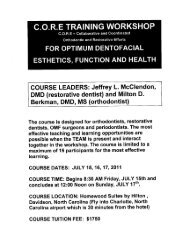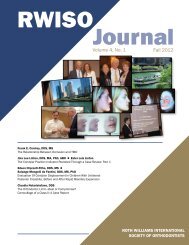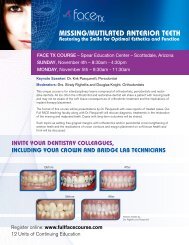2010 RWISO Journal - Roth Williams International Society of ...
2010 RWISO Journal - Roth Williams International Society of ...
2010 RWISO Journal - Roth Williams International Society of ...
Create successful ePaper yourself
Turn your PDF publications into a flip-book with our unique Google optimized e-Paper software.
Effect <strong>of</strong> Gnathologic Positioner Wear on Maximum<br />
Intercuspation CR Disharmony<br />
Wesley M. Chiang, DDS, MS ■ Theodore Freeland, DDS, MS<br />
■ Richard Kulbersh, DMD, MS, PLC ■ Richard Kaczynski, BS, MS, PhD<br />
We S L e y m. ch i a n G , ddS, mS<br />
■ MA Candidate, Orthodontic Dept.,<br />
University <strong>of</strong> Detroit Mercy School<br />
<strong>of</strong> Dentistry<br />
The o d o R e FR e e L a n d, ddS, mS<br />
tdfortho@freelandorthodontics.com<br />
■ Adjunct Pr<strong>of</strong>essor, Orthodontic<br />
Dept., University <strong>of</strong> Detroit Mercy<br />
School <strong>of</strong> Dentistry<br />
■ Director <strong>Roth</strong>/<strong>Williams</strong> USA;<br />
■ Private Practice, Gaylord, MI<br />
Ric h a R d Ku L b e R S h, dmd, mS, PLc<br />
■ Program Director, Orthodontic<br />
Dept., University <strong>of</strong> Detroit Mercy<br />
School <strong>of</strong> Dentistry<br />
Ric h a R d Ka c z y n S K i , bS, mS, Phd<br />
■ Statistician, Dept. <strong>of</strong> Psychiatry,<br />
Yale University School <strong>of</strong> Medicine<br />
Introduction<br />
Centric relation (CR) refers to a physiologic position <strong>of</strong> the<br />
mandible when the condyles are located in the superoanterior<br />
position in the articular fossae, fully seated and resting<br />
against the posterior slopes <strong>of</strong> the articular eminences with<br />
the discs properly interposed. 1 It is a reproducible position<br />
that is obtained independent <strong>of</strong> the occlusion by manipulating<br />
the mandible in a purely rotary movement about the<br />
transverse horizontal axis. 2<br />
Orthodontic treatment is aimed at achieving static goals<br />
from Andrews’ six keys to normal occlusion and the functional<br />
scheme <strong>of</strong> mutually protected occlusion recommended<br />
by Stuart and Stallard. 3,4 In the 1970s, <strong>Roth</strong> introduced gna-<br />
Summary<br />
The goal <strong>of</strong> a gnathological approach in orthodontics is to achieve a functional<br />
occlusion, in which the mandible can close into maximum intercuspation (MI) without<br />
deflecting the condyles from centric relation (CR). Gnathologic positioners are<br />
used at the end <strong>of</strong> orthodontic treatment to settle the occlusion while maintaining<br />
MI-CR harmony. The objective <strong>of</strong> this prospective study was to examine the effect<br />
<strong>of</strong> gnathologic positioners on MI-CR discrepancy for patients treated with the <strong>Roth</strong><br />
gnathological approach.<br />
Methods.The sample consisted <strong>of</strong> 26 consecutively finished cases in a gnathologically<br />
oriented practice. All cases were treated with a gnathological treatment approach,<br />
using the <strong>Roth</strong> prescription straight-wire appliance. A gnathologic positioner was<br />
delivered at the time <strong>of</strong> debonding and was worn for a period <strong>of</strong> 2 months. Pre- and<br />
postpositioner records were taken. These included a maximum-intercuspation wax<br />
bite; a two-piece <strong>Roth</strong> power centric CR bite registration; and upper and lower models<br />
mounted using a true hinge transfer and CR bite. The control group consisted <strong>of</strong> 8<br />
randomly selected finished cases in the orthodontic clinic at the University <strong>of</strong> Detroit<br />
Mercy and was retained with Hawley retainers. MI-CR discrepancy was measured<br />
with a condylar position Indicator (CPI).<br />
Results. Results indicate a statistically significant improvement in MI-CR discrepancy<br />
in the right horizontal, right vertical, left vertical, and transverse planes after 2 months<br />
<strong>of</strong> gnathologic positioner wear. The amount <strong>of</strong> condylar distraction in these 4 measurements<br />
showed statistically significant improvement and came within the envelope<br />
<strong>of</strong> susceptibility.<br />
Conclusions.The positioner and control groups tend to change differently over time<br />
in the vertical and horizontal planes, with the positioner group improving and the<br />
control group getting worse. In the transverse plane, gnathologic positioners improve<br />
the result <strong>of</strong> orthodontic treatment with respect to condylar axis distraction.<br />
thological concepts into orthodontic treatment. 5,6,7 The goal<br />
<strong>of</strong> a gnathological approach in orthodontics is to achieve a<br />
functional occlusion, in which the mandible can close into<br />
maximum intercuspation (MI) without deflecting the condyles<br />
from CR. 8 Dr. <strong>Roth</strong> believed that a large discrepancy<br />
between MI and CR can lead to breakdown in the stomatognathic<br />
system, because the condyles are distracted from<br />
the glenoid fossae when the teeth come into occlusion. Signs<br />
and symptoms <strong>of</strong> occlusal disharmony include temporomandibular<br />
joint pain-dysfunction syndrome, occlusal wear and<br />
bruxism, excessive tooth mobility associated with periodontal<br />
disease, and movement or relapse <strong>of</strong> tooth positions. 9<br />
Occlusal discrepancies, if associated with joint compression,<br />
<strong>RWISO</strong> <strong>Journal</strong> | September <strong>2010</strong><br />
75








